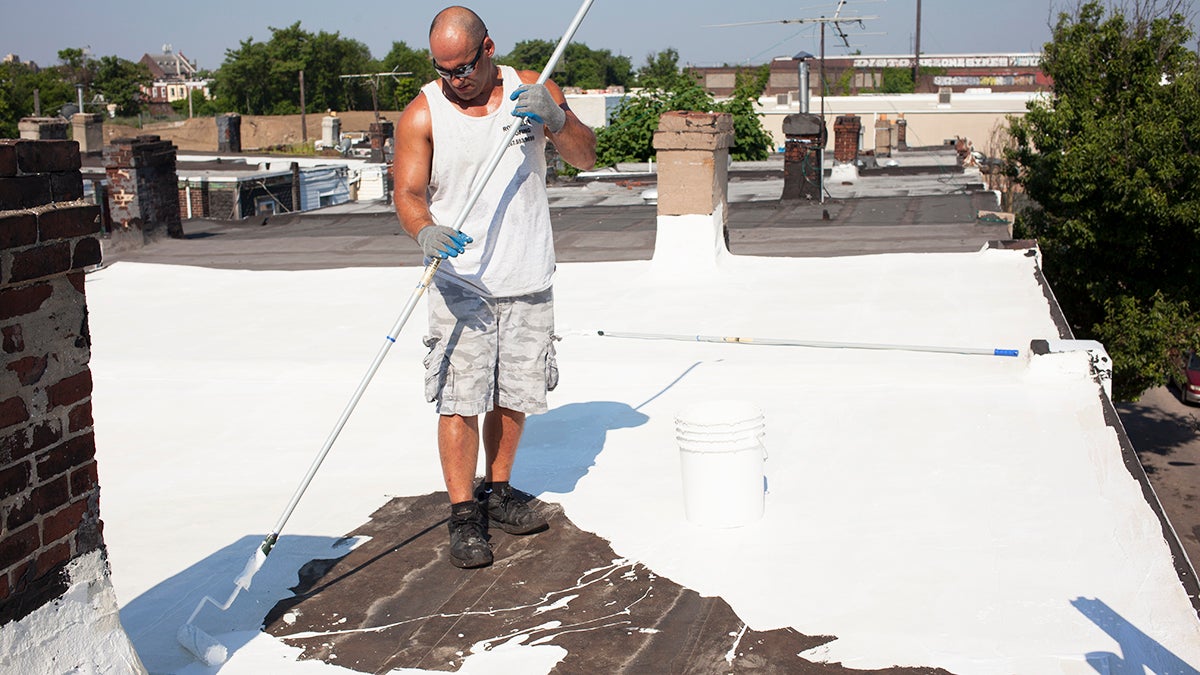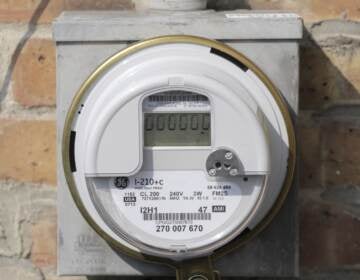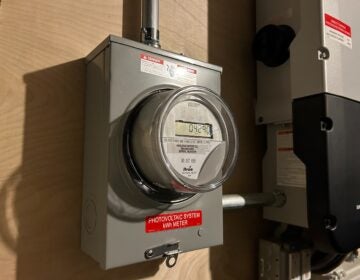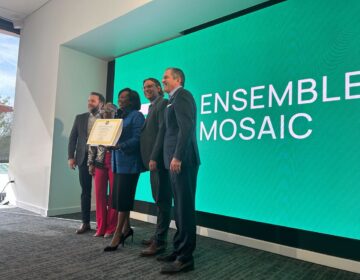A hotter topic: Building heat resilience into multifamily housing
Affordable multifamily housing is the most vulnerable building sector when it comes to extreme weather, and its residents have fewer resources.

Roofer Rob Nolfi applies a reflective topping on a rehabbed roof in North Philadelphia. Cool roofs help keep temperatures down when the city heats up. (Irina Zhorov/The Pulse)
This story originally appeared on PlanPhilly.
—
Summers are getting hotter in Philadelphia. The average daily temperature in the eastern half of Pennsylvania has risen about two degrees Fahrenheit in the last three decades. Since May, the city has experienced 17 days with high temperatures above 90 degrees and three above 95, according to the Pennsylvania State Climatologist. And it’s predicted that temperatures will continue to climb: By the end of the century, the city may experience four to 10 times as many days per year above 95 degrees.
But according to Philadelphia’s heat-vulnerability index, which overlays temperature data with sociodemographic and health data, heat doesn’t affect the entire city the same way. Extreme heat events affect low-income neighborhoods disproportionally.
“We need to focus on how lower-income communities can manage long-term recovery after [natural disasters] and how we’re helping them prepare,” said Shelby O’Neill, who develops resilience strategies for multifamily-housing buildings for Enterprise Community Partners, a national nonprofit. “Extreme weather is really the status quo now.”
And extreme weather, like natural disasters, can result in power outages that render electric fans and air conditioners useless on hot days.
Affordable multifamily housing is the most vulnerable building sector when it comes to extreme circumstances, and its residents have fewer resources. “Lower [income] populations are the first victims and the last ones to recover,” O’Neill said at a conference on climate change and affordable housing organized by Green Building United in Philadelphia. That’s why property owners, developers, and homeowners need to consider extreme weather when investing in future development.
How can multifamily buildings prepare for extreme heat? Two things that help are backup generators and insulation, said Thomas Chase, senior project manager for New Ecology, a nonprofit that works with Enterprise to develop resilience and recovery strategies and that also did a presentation at the conference.
“The first thing we push is always the envelope,” Chase said. “A well-insulated, air-sealed envelope that mitigates thermal swings becomes a more resilient building even when the power is out.”
A passive house, one with a good thermal envelope and insulation and that doesn’t rely on mechanical solutions for climatization, is the ideal, he said. Apartments built under that energy-efficiency standard can be habitable for up to a week during a heat event with no electricity, he noted, while a normal construction becomes uninhabitable in half a day.
A backup generator can allow residents to run their cooling units after an outage, but Chase strongly recommends solar power plus battery storage.
“One of the things we learned after [Hurricane] Sandy is that 60 percent of generators failed. If they’re diesel, they run out of fuel and they can’t get it delivered. If they’re natural gas, the city shuts down the natural gas to prevent fires,” Chase said.
Operable windows are critical for ventilation and air movement, and good-quality windows are better at keeping the heat outside.
“The weak point in the [building] envelope is the windows,” Chase said, because they’re expensive and the investment only pays back in 40 to 50 years. “But buying a good window means you don’t have leaks and you don’t have to replace the window every 10 years.”
On the cheaper end, Chase recommended light-color roofs that reflect the direct heat from the sun.
Trees, too. “Trees are massively important,” he said. “Plant as [many] trees as you can.”
Chris Benedict, an architect who specializes in energy-efficient building and passive-house strategies, was the keynote speaker at the conference. Going back to ancient cooling techniques is critical, she said.
“There was a time when we had no AC and we did things with our houses that now we don’t do, because we close them up and we air-condition,” Benedict told PlanPhilly.
Some of those techniques include not putting a lot of glass on the south side of a building, where there’s more sun exposure. If you do, use shading. In addition, figure out a way to move air through the building with fans, and open windows and doors for ventilation only at night, when it’s cooler outside.
Enterprise Community Partners has developed a national resiliency guide with 19 practical strategies for building owners to make their properties ready to respond to natural disasters and prevent the negative effects of extreme weather events.
Philadelphia’s heat-resilience plan for affordable and public housing
According to the city Office of Sustainability’s 2015 climate change adaptation plan, Philadelphia’s buildings and infrastructure “were designed to withstand past climate conditions, not those that scientists expect will occur in the future.” Over time, the document says, prolonged exposure to extreme heat and rain may lead to higher risk and maintenance costs.
To prevent that, city officials told PlanPhilly, municipal agencies are applying several strategies to adapt new and existing housing stock to the new climate reality, and to heat in particular. For now, most of those strategies have to do with energy efficiency.
In May, City Council approved modern building codes for commercial and multifamily buildings. Adoption of the 2018 International Building Code will increase energy efficiency in buildings by more than 30 percent compared to the 2009 code it replaces, and will increase demand for energy-efficient equipment, bringing the price of cooling and heating systems down. The new code also mandates specific building materials and construction practices according to updated climate zones, making new construction more resilient to the effects of climate change.
Since 2010, Philadelphia has required that all new construction or major renovation funded more than 50 percent by the city achieve LEED Silver certification, a green-building rating that ensures energy efficiency. Also required since 2010 is that all new construction and major-renovation developments have cool reflective roofs.
“That [requirement] has been very effective since its existence as a law, but if you look at GSI mapping you can still see swaths of the city where there’s still a lot of black roofs, and a lot of that comes down to the ability of the homeowner to invest in their home,” said Christine Knapp, director of the Office of Sustainability.
The city also promotes energy efficiency in all Division of Housing and Community Development affordable-housing Request for Proposals, and in developments funded either by the Philadelphia Redevelopment Authority or the Pennsylvania Housing Finance Agency, according to Paul Chrystie, spokesman for Philadelphia’s Department of Planning and Development. Developers are encouraged to include energy audits and modeling, use sustainable appliances, and achieve LEED (Leadership in Energy and Environmental Design), Energy Star, or Enterprise Green Communities certification. Developers that meet passive-house requirements for energy efficiency get economic incentives.
All future projects developed by the Philadelphia Housing Authority must meet minimum criteria for Energy Star construction, which considers site conditions such as best solar orientation for placing a building, Energy Star-rated stoves and refrigerators, white roofs, ceiling and wall insulation and air sealing, cool light fixtures, air-conditioning units, and thermally sealed doors and windows.
The Philadelphia Energy Authority preserves existing affordable housing including multifamily units, focusing on energy efficiency and climate resiliency. PEA’s Energy Campaign is “an unlikely success story of a municipal climate initiative prioritizing the needs of its low-income and minority residents, transcending the disconnect between equity and environment by addressing affordable, safe housing through energy policy,” wrote Caroline Lauer, a recent graduate of the Harvard Graduate School of Design, whose thesis on the campaign was selected as the best paper on housing by the university’s Joint Center for Housing Studies.
The Energy Coordinating Agency also provides energy-efficiency retrofits for existing residential properties and offers multiple resources for weatherization, including tips for keeping houses and people cool during the summer. Philadelphia Housing Development Corp. offers weatherization programs that include help getting better insulation for low-income homeowners.
The Office of Sustainability is coordinating the work of different city agencies to address heat vulnerability and running a pilot program to “beat the heat” in Hunting Park, one of the most heat-affected neighborhoods in the city.
Among the solutions the office is considering is helping homeowners that can’t prove they own their properties to get their titles untangled so they can obtain home-improvement and energy-efficiency loans.
WHYY is your source for fact-based, in-depth journalism and information. As a nonprofit organization, we rely on financial support from readers like you. Please give today.







